Discrete Mathematics Assignment: Question Solutions and Analysis
VerifiedAdded on 2020/04/21
|9
|1133
|119
Homework Assignment
AI Summary
This document presents solutions to a discrete mathematics assignment, addressing several key concepts. Question 1 explores set theory, providing a Venn diagram representation of universal sets and subsets. Question 2 delves into relations on a set of cities and flights, analyzing the properties of equivalence relations, including reflexivity, symmetry, and transitivity, and demonstrating how to partition the set into equivalence classes. Question 3 examines functions, specifically the modulus function, determining whether it is one-to-one and onto, and then modifying the function to re-evaluate these properties. Question 4 focuses on sequences, calculating the first ten terms of various sequences defined by different rules. Finally, Question 5 investigates truth tables, constructing truth tables for logical statements, analyzing the applicability of the contrapositive law, and identifying whether the given statement is a contingency or tautology.

CBMA2103MATHEMATIC DISCRETE
ASSIGNMENT
Student id and name
[Pick the date]
ASSIGNMENT
Student id and name
[Pick the date]
Paraphrase This Document
Need a fresh take? Get an instant paraphrase of this document with our AI Paraphraser
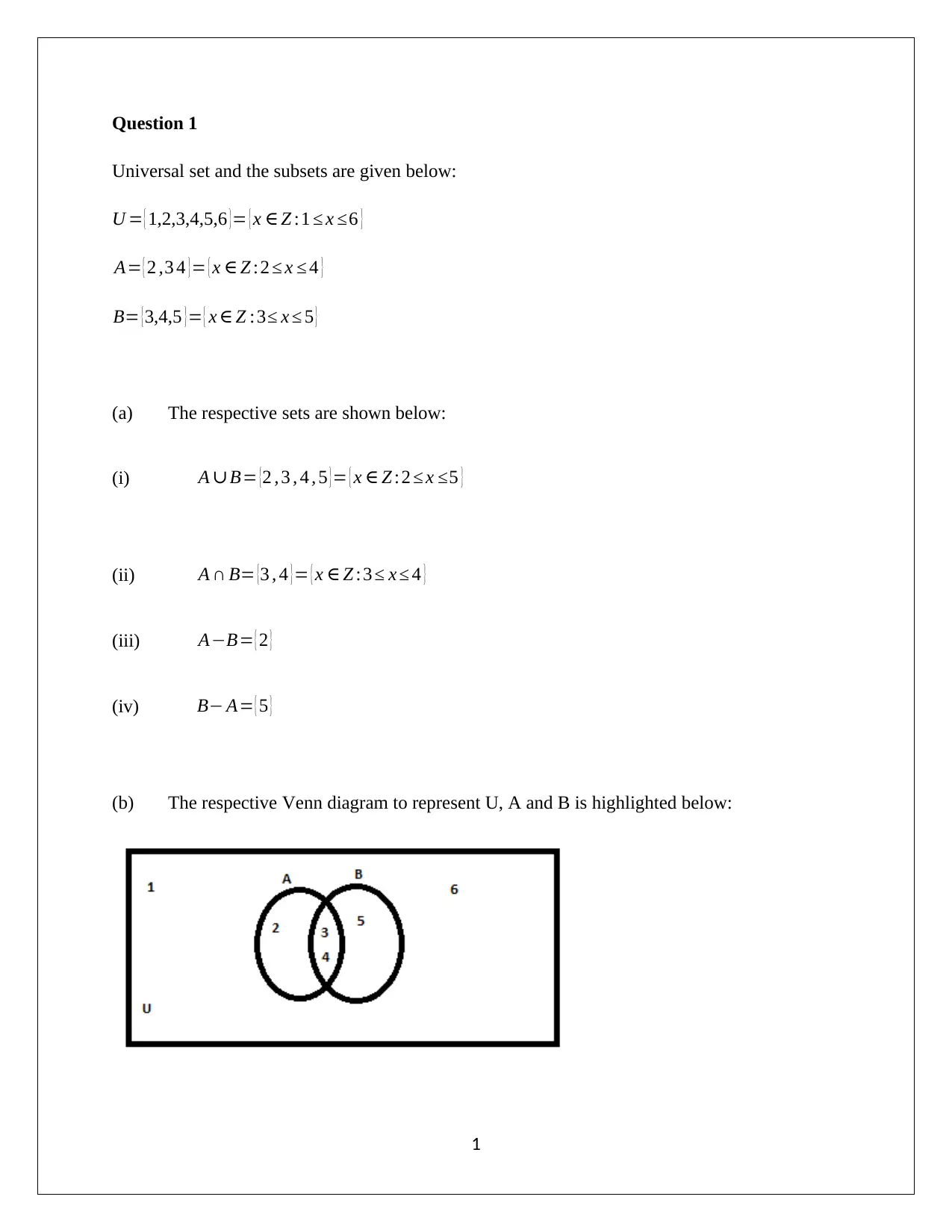
Question 1
Universal set and the subsets are given below:
U = { 1,2,3,4,5,6 }= { x ∈ Z :1 ≤ x ≤6 }
A= { 2 ,3 4 }= { x ∈ Z :2 ≤ x ≤ 4 }
B= {3,4,5 }= { x ∈ Z :3≤ x ≤ 5 }
(a) The respective sets are shown below:
(i) A ∪B= {2 , 3 , 4 , 5 }= { x ∈ Z :2 ≤ x ≤5 }
(ii) A ∩ B= {3 , 4 }= { x ∈ Z :3 ≤ x ≤ 4 }
(iii) A−B= { 2 }
(iv) B− A= { 5 }
(b) The respective Venn diagram to represent U, A and B is highlighted below:
1
Universal set and the subsets are given below:
U = { 1,2,3,4,5,6 }= { x ∈ Z :1 ≤ x ≤6 }
A= { 2 ,3 4 }= { x ∈ Z :2 ≤ x ≤ 4 }
B= {3,4,5 }= { x ∈ Z :3≤ x ≤ 5 }
(a) The respective sets are shown below:
(i) A ∪B= {2 , 3 , 4 , 5 }= { x ∈ Z :2 ≤ x ≤5 }
(ii) A ∩ B= {3 , 4 }= { x ∈ Z :3 ≤ x ≤ 4 }
(iii) A−B= { 2 }
(iv) B− A= { 5 }
(b) The respective Venn diagram to represent U, A and B is highlighted below:
1
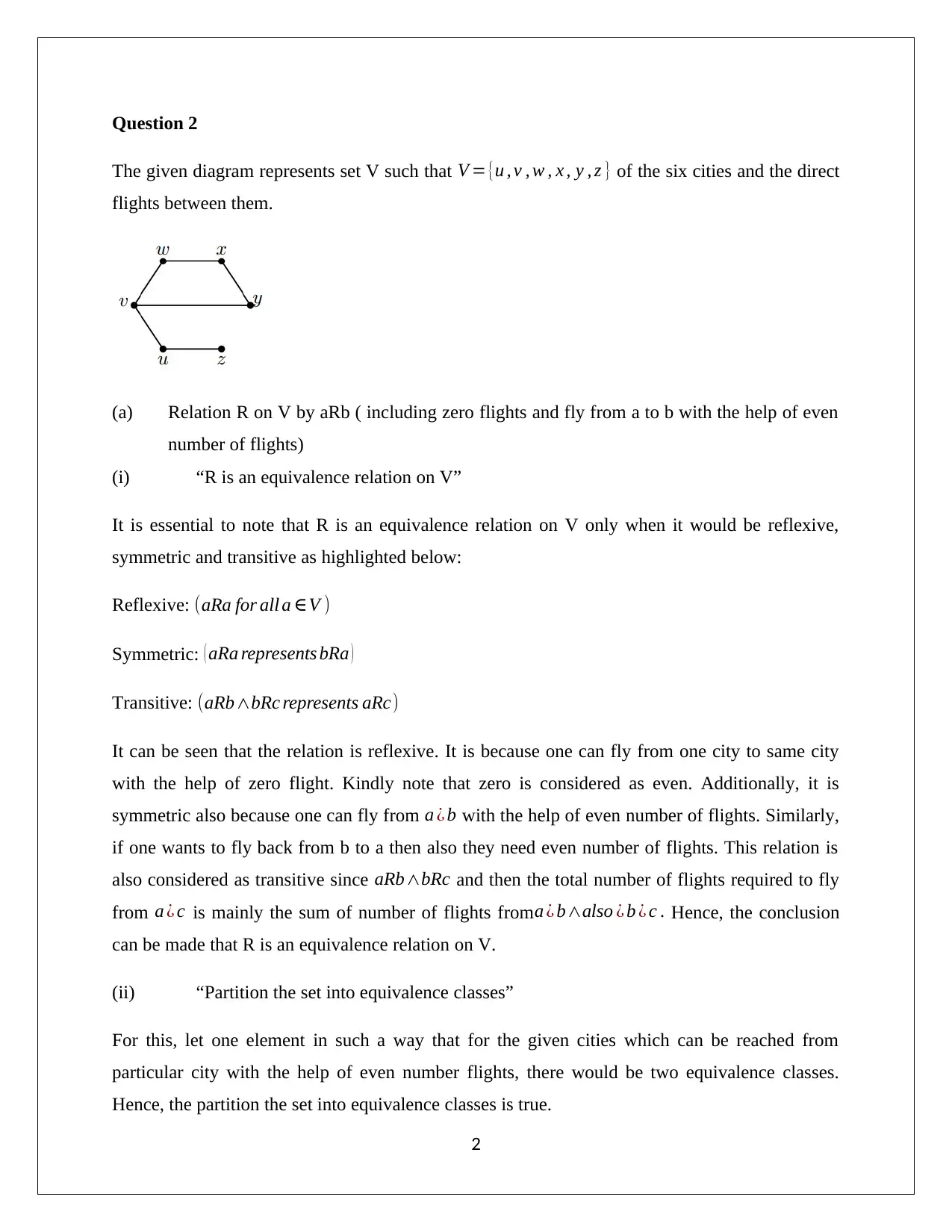
Question 2
The given diagram represents set V such that V ={u , v , w , x , y , z } of the six cities and the direct
flights between them.
(a) Relation R on V by aRb ( including zero flights and fly from a to b with the help of even
number of flights)
(i) “R is an equivalence relation on V”
It is essential to note that R is an equivalence relation on V only when it would be reflexive,
symmetric and transitive as highlighted below:
Reflexive: (aRa for all a ∈V )
Symmetric: ( aRa represents bRa )
Transitive: (aRb∧bRc represents aRc)
It can be seen that the relation is reflexive. It is because one can fly from one city to same city
with the help of zero flight. Kindly note that zero is considered as even. Additionally, it is
symmetric also because one can fly from a ¿ b with the help of even number of flights. Similarly,
if one wants to fly back from b to a then also they need even number of flights. This relation is
also considered as transitive since aRb∧bRc and then the total number of flights required to fly
from a ¿ c is mainly the sum of number of flights from a ¿ b∧also ¿ b ¿ c . Hence, the conclusion
can be made that R is an equivalence relation on V.
(ii) “Partition the set into equivalence classes”
For this, let one element in such a way that for the given cities which can be reached from
particular city with the help of even number flights, there would be two equivalence classes.
Hence, the partition the set into equivalence classes is true.
2
The given diagram represents set V such that V ={u , v , w , x , y , z } of the six cities and the direct
flights between them.
(a) Relation R on V by aRb ( including zero flights and fly from a to b with the help of even
number of flights)
(i) “R is an equivalence relation on V”
It is essential to note that R is an equivalence relation on V only when it would be reflexive,
symmetric and transitive as highlighted below:
Reflexive: (aRa for all a ∈V )
Symmetric: ( aRa represents bRa )
Transitive: (aRb∧bRc represents aRc)
It can be seen that the relation is reflexive. It is because one can fly from one city to same city
with the help of zero flight. Kindly note that zero is considered as even. Additionally, it is
symmetric also because one can fly from a ¿ b with the help of even number of flights. Similarly,
if one wants to fly back from b to a then also they need even number of flights. This relation is
also considered as transitive since aRb∧bRc and then the total number of flights required to fly
from a ¿ c is mainly the sum of number of flights from a ¿ b∧also ¿ b ¿ c . Hence, the conclusion
can be made that R is an equivalence relation on V.
(ii) “Partition the set into equivalence classes”
For this, let one element in such a way that for the given cities which can be reached from
particular city with the help of even number flights, there would be two equivalence classes.
Hence, the partition the set into equivalence classes is true.
2
⊘ This is a preview!⊘
Do you want full access?
Subscribe today to unlock all pages.

Trusted by 1+ million students worldwide
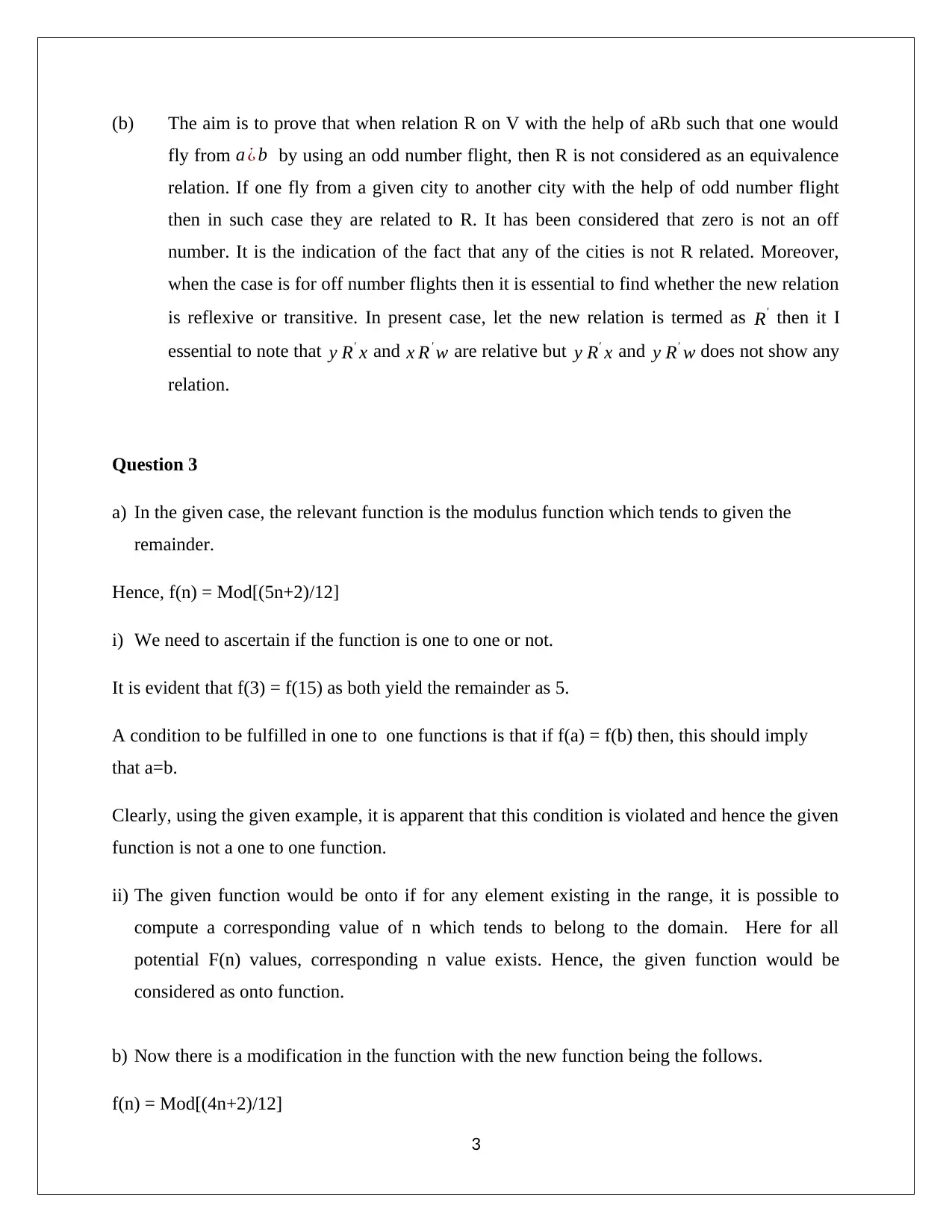
(b) The aim is to prove that when relation R on V with the help of aRb such that one would
fly from a ¿ b by using an odd number flight, then R is not considered as an equivalence
relation. If one fly from a given city to another city with the help of odd number flight
then in such case they are related to R. It has been considered that zero is not an off
number. It is the indication of the fact that any of the cities is not R related. Moreover,
when the case is for off number flights then it is essential to find whether the new relation
is reflexive or transitive. In present case, let the new relation is termed as R' then it I
essential to note that y R' x and x R' w are relative but y R' x and y R' w does not show any
relation.
Question 3
a) In the given case, the relevant function is the modulus function which tends to given the
remainder.
Hence, f(n) = Mod[(5n+2)/12]
i) We need to ascertain if the function is one to one or not.
It is evident that f(3) = f(15) as both yield the remainder as 5.
A condition to be fulfilled in one to one functions is that if f(a) = f(b) then, this should imply
that a=b.
Clearly, using the given example, it is apparent that this condition is violated and hence the given
function is not a one to one function.
ii) The given function would be onto if for any element existing in the range, it is possible to
compute a corresponding value of n which tends to belong to the domain. Here for all
potential F(n) values, corresponding n value exists. Hence, the given function would be
considered as onto function.
b) Now there is a modification in the function with the new function being the follows.
f(n) = Mod[(4n+2)/12]
3
fly from a ¿ b by using an odd number flight, then R is not considered as an equivalence
relation. If one fly from a given city to another city with the help of odd number flight
then in such case they are related to R. It has been considered that zero is not an off
number. It is the indication of the fact that any of the cities is not R related. Moreover,
when the case is for off number flights then it is essential to find whether the new relation
is reflexive or transitive. In present case, let the new relation is termed as R' then it I
essential to note that y R' x and x R' w are relative but y R' x and y R' w does not show any
relation.
Question 3
a) In the given case, the relevant function is the modulus function which tends to given the
remainder.
Hence, f(n) = Mod[(5n+2)/12]
i) We need to ascertain if the function is one to one or not.
It is evident that f(3) = f(15) as both yield the remainder as 5.
A condition to be fulfilled in one to one functions is that if f(a) = f(b) then, this should imply
that a=b.
Clearly, using the given example, it is apparent that this condition is violated and hence the given
function is not a one to one function.
ii) The given function would be onto if for any element existing in the range, it is possible to
compute a corresponding value of n which tends to belong to the domain. Here for all
potential F(n) values, corresponding n value exists. Hence, the given function would be
considered as onto function.
b) Now there is a modification in the function with the new function being the follows.
f(n) = Mod[(4n+2)/12]
3
Paraphrase This Document
Need a fresh take? Get an instant paraphrase of this document with our AI Paraphraser
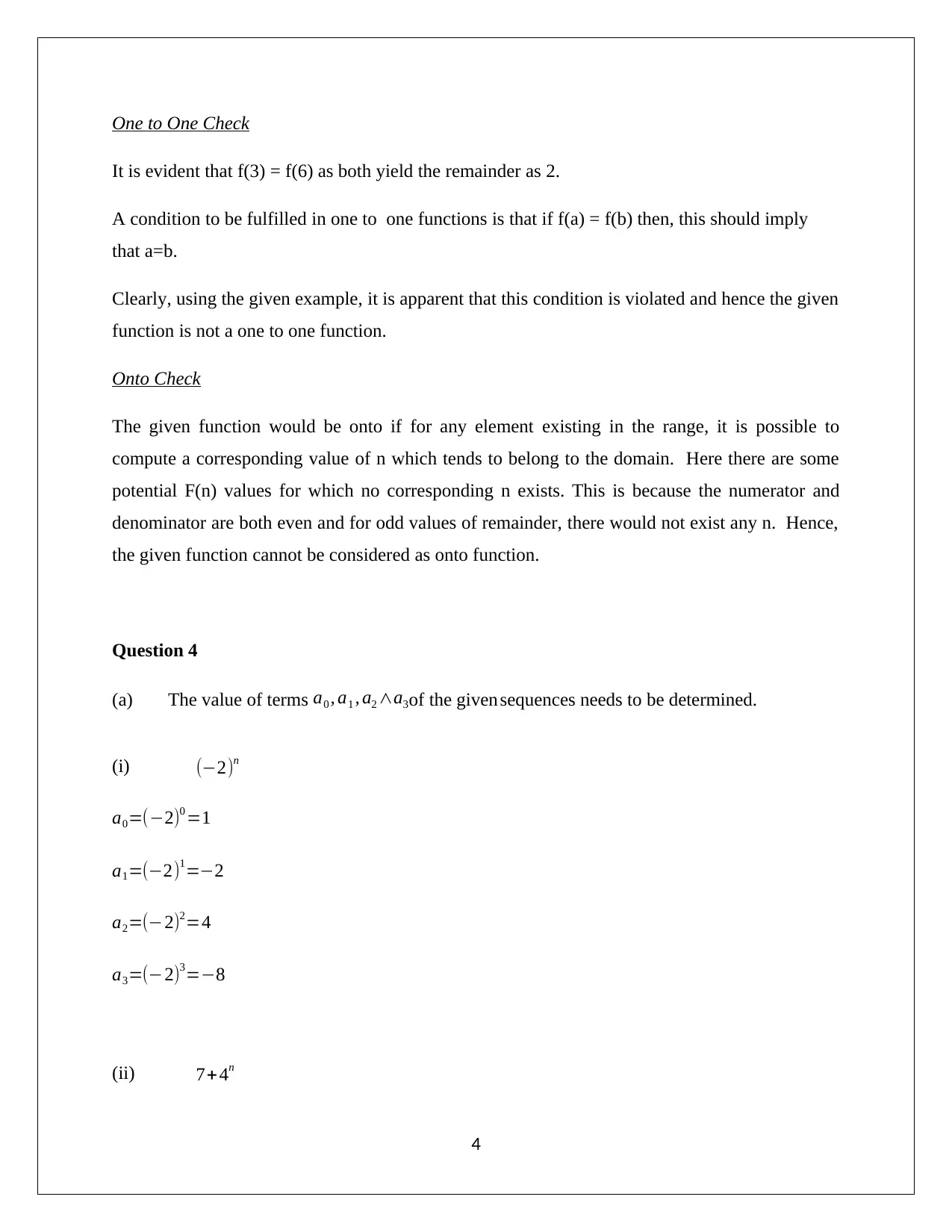
One to One Check
It is evident that f(3) = f(6) as both yield the remainder as 2.
A condition to be fulfilled in one to one functions is that if f(a) = f(b) then, this should imply
that a=b.
Clearly, using the given example, it is apparent that this condition is violated and hence the given
function is not a one to one function.
Onto Check
The given function would be onto if for any element existing in the range, it is possible to
compute a corresponding value of n which tends to belong to the domain. Here there are some
potential F(n) values for which no corresponding n exists. This is because the numerator and
denominator are both even and for odd values of remainder, there would not exist any n. Hence,
the given function cannot be considered as onto function.
Question 4
(a) The value of terms a0 , a1 , a2 ∧a3of the given sequences needs to be determined.
(i) (−2)n
a0=(−2)0 =1
a1=(−2)1=−2
a2=(−2)2=4
a3=(−2)3=−8
(ii) 7+4n
4
It is evident that f(3) = f(6) as both yield the remainder as 2.
A condition to be fulfilled in one to one functions is that if f(a) = f(b) then, this should imply
that a=b.
Clearly, using the given example, it is apparent that this condition is violated and hence the given
function is not a one to one function.
Onto Check
The given function would be onto if for any element existing in the range, it is possible to
compute a corresponding value of n which tends to belong to the domain. Here there are some
potential F(n) values for which no corresponding n exists. This is because the numerator and
denominator are both even and for odd values of remainder, there would not exist any n. Hence,
the given function cannot be considered as onto function.
Question 4
(a) The value of terms a0 , a1 , a2 ∧a3of the given sequences needs to be determined.
(i) (−2)n
a0=(−2)0 =1
a1=(−2)1=−2
a2=(−2)2=4
a3=(−2)3=−8
(ii) 7+4n
4
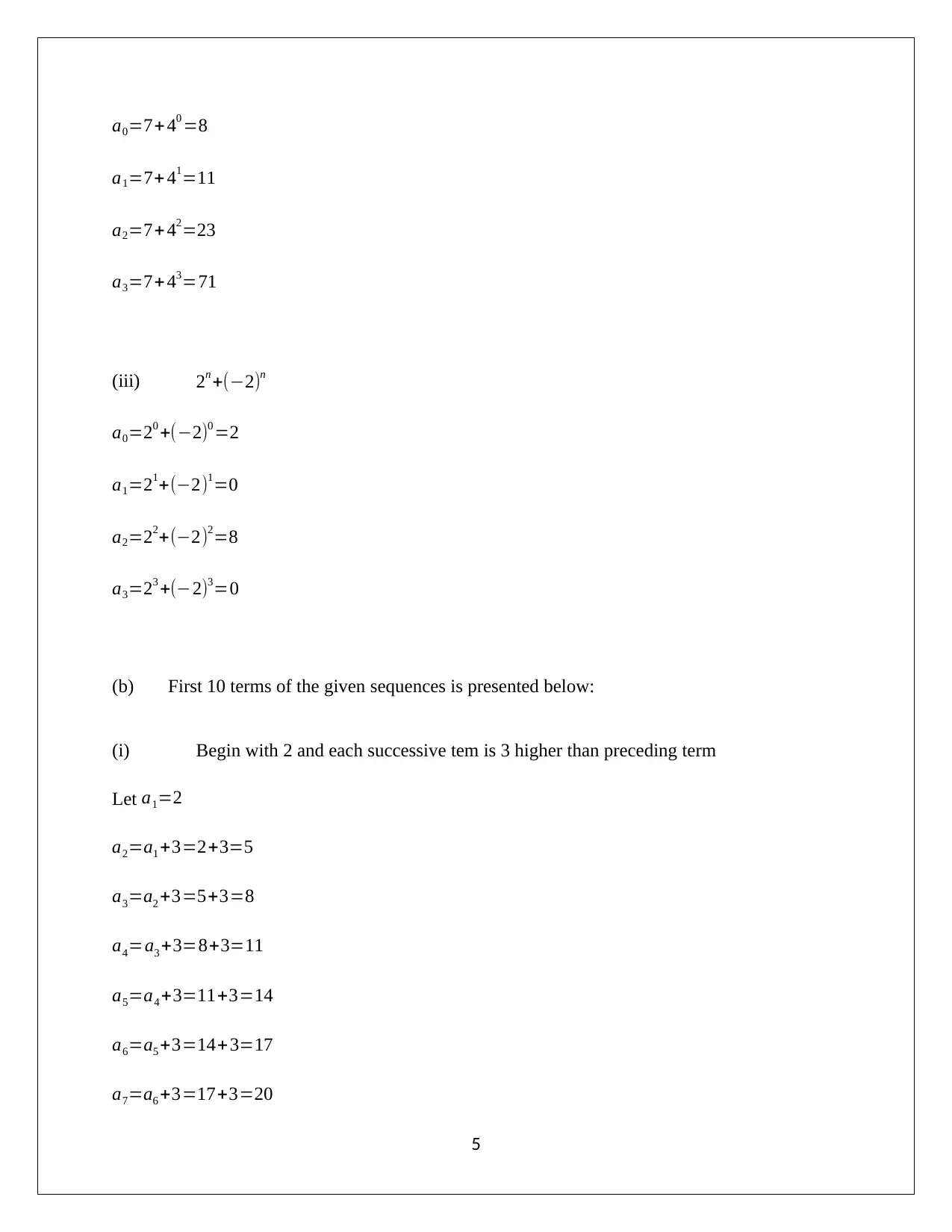
a0=7+ 40 =8
a1=7+ 41=11
a2=7+ 42=23
a3=7+ 43=71
(iii) 2n +(−2)n
a0=20 +(−2)0 =2
a1=21+(−2)1=0
a2=22+(−2)2=8
a3=23 +(−2)3=0
(b) First 10 terms of the given sequences is presented below:
(i) Begin with 2 and each successive tem is 3 higher than preceding term
Let a1=2
a2=a1 +3=2+3=5
a3=a2 +3=5+3=8
a4=a3 +3=8+3=11
a5=a4 +3=11+3=14
a6=a5 +3=14+3=17
a7=a6 +3=17+3=20
5
a1=7+ 41=11
a2=7+ 42=23
a3=7+ 43=71
(iii) 2n +(−2)n
a0=20 +(−2)0 =2
a1=21+(−2)1=0
a2=22+(−2)2=8
a3=23 +(−2)3=0
(b) First 10 terms of the given sequences is presented below:
(i) Begin with 2 and each successive tem is 3 higher than preceding term
Let a1=2
a2=a1 +3=2+3=5
a3=a2 +3=5+3=8
a4=a3 +3=8+3=11
a5=a4 +3=11+3=14
a6=a5 +3=14+3=17
a7=a6 +3=17+3=20
5
⊘ This is a preview!⊘
Do you want full access?
Subscribe today to unlock all pages.

Trusted by 1+ million students worldwide
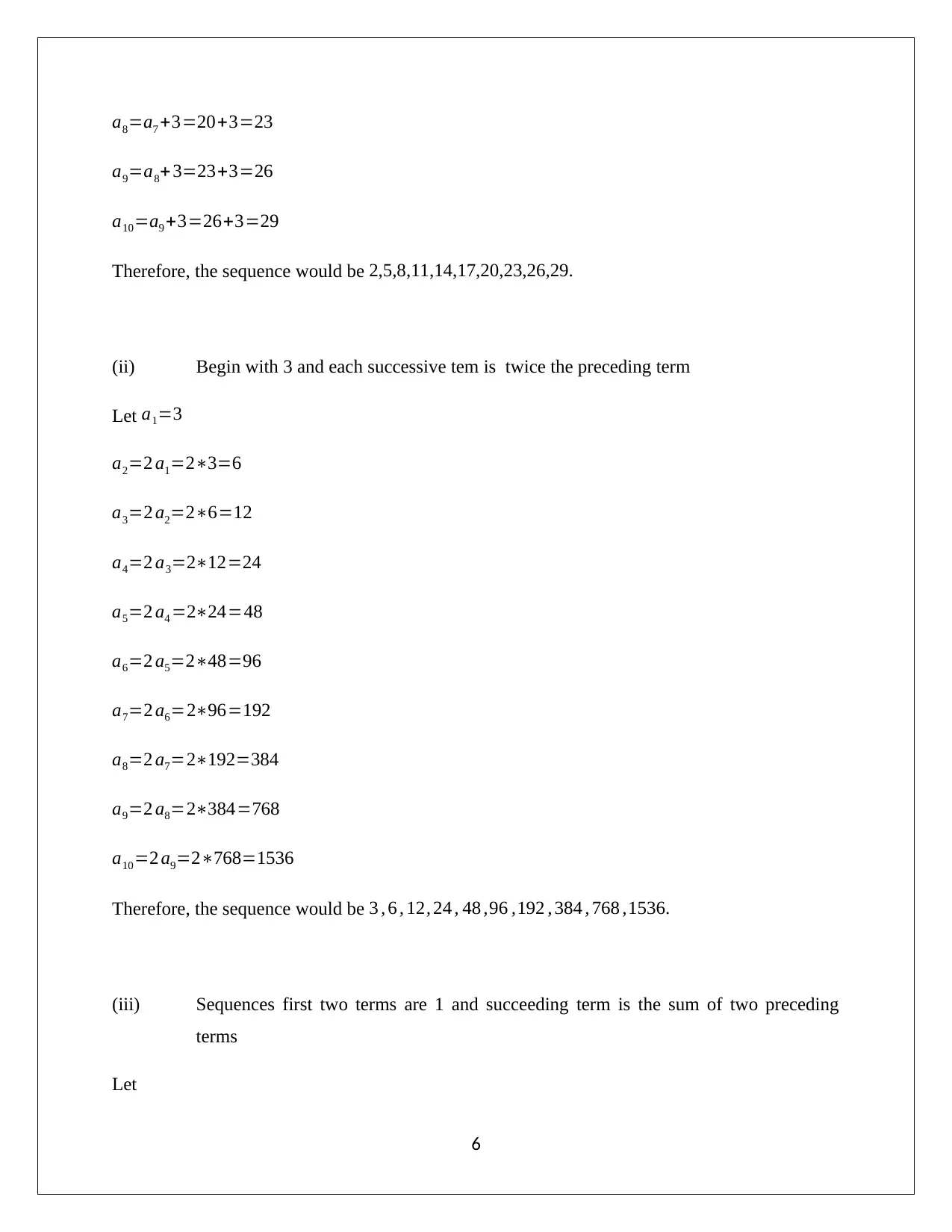
a8=a7 +3=20+3=23
a9=a8+ 3=23+3=26
a10=a9 +3=26+3=29
Therefore, the sequence would be 2,5,8,11,14,17,20,23,26,29.
(ii) Begin with 3 and each successive tem is twice the preceding term
Let a1=3
a2=2 a1=2∗3=6
a3=2 a2=2∗6=12
a4=2 a3=2∗12=24
a5=2 a4 =2∗24=48
a6=2 a5=2∗48=96
a7=2 a6=2∗96=192
a8=2 a7=2∗192=384
a9=2 a8=2∗384=768
a10=2 a9=2∗768=1536
Therefore, the sequence would be 3 , 6 , 12, 24 , 48 ,96 ,192 , 384 , 768 ,1536.
(iii) Sequences first two terms are 1 and succeeding term is the sum of two preceding
terms
Let
6
a9=a8+ 3=23+3=26
a10=a9 +3=26+3=29
Therefore, the sequence would be 2,5,8,11,14,17,20,23,26,29.
(ii) Begin with 3 and each successive tem is twice the preceding term
Let a1=3
a2=2 a1=2∗3=6
a3=2 a2=2∗6=12
a4=2 a3=2∗12=24
a5=2 a4 =2∗24=48
a6=2 a5=2∗48=96
a7=2 a6=2∗96=192
a8=2 a7=2∗192=384
a9=2 a8=2∗384=768
a10=2 a9=2∗768=1536
Therefore, the sequence would be 3 , 6 , 12, 24 , 48 ,96 ,192 , 384 , 768 ,1536.
(iii) Sequences first two terms are 1 and succeeding term is the sum of two preceding
terms
Let
6
Paraphrase This Document
Need a fresh take? Get an instant paraphrase of this document with our AI Paraphraser
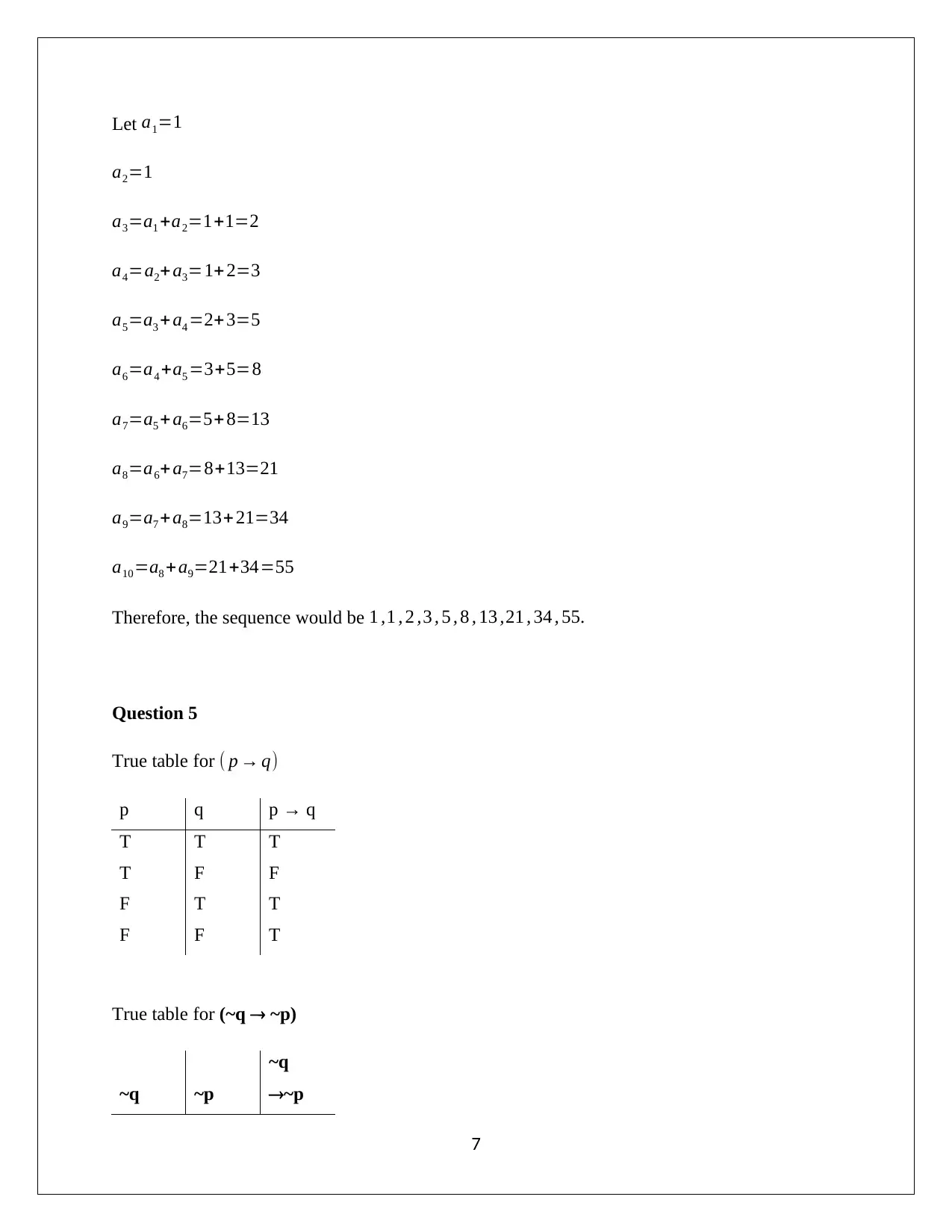
Let a1=1
a2=1
a3=a1 +a2=1+1=2
a4=a2+a3=1+ 2=3
a5=a3 +a4 =2+3=5
a6=a4 +a5 =3+5=8
a7=a5 + a6=5+ 8=13
a8=a6+a7=8+13=21
a9=a7 +a8=13+ 21=34
a10=a8 +a9=21+34=55
Therefore, the sequence would be 1 ,1 , 2 ,3 , 5 , 8 , 13 ,21 , 34 , 55.
Question 5
True table for ( p → q)
p q p → q
T T T
T F F
F T T
F F T
True table for (~q ~p)
~q ~p
~q
~p
7
a2=1
a3=a1 +a2=1+1=2
a4=a2+a3=1+ 2=3
a5=a3 +a4 =2+3=5
a6=a4 +a5 =3+5=8
a7=a5 + a6=5+ 8=13
a8=a6+a7=8+13=21
a9=a7 +a8=13+ 21=34
a10=a8 +a9=21+34=55
Therefore, the sequence would be 1 ,1 , 2 ,3 , 5 , 8 , 13 ,21 , 34 , 55.
Question 5
True table for ( p → q)
p q p → q
T T T
T F F
F T T
F F T
True table for (~q ~p)
~q ~p
~q
~p
7
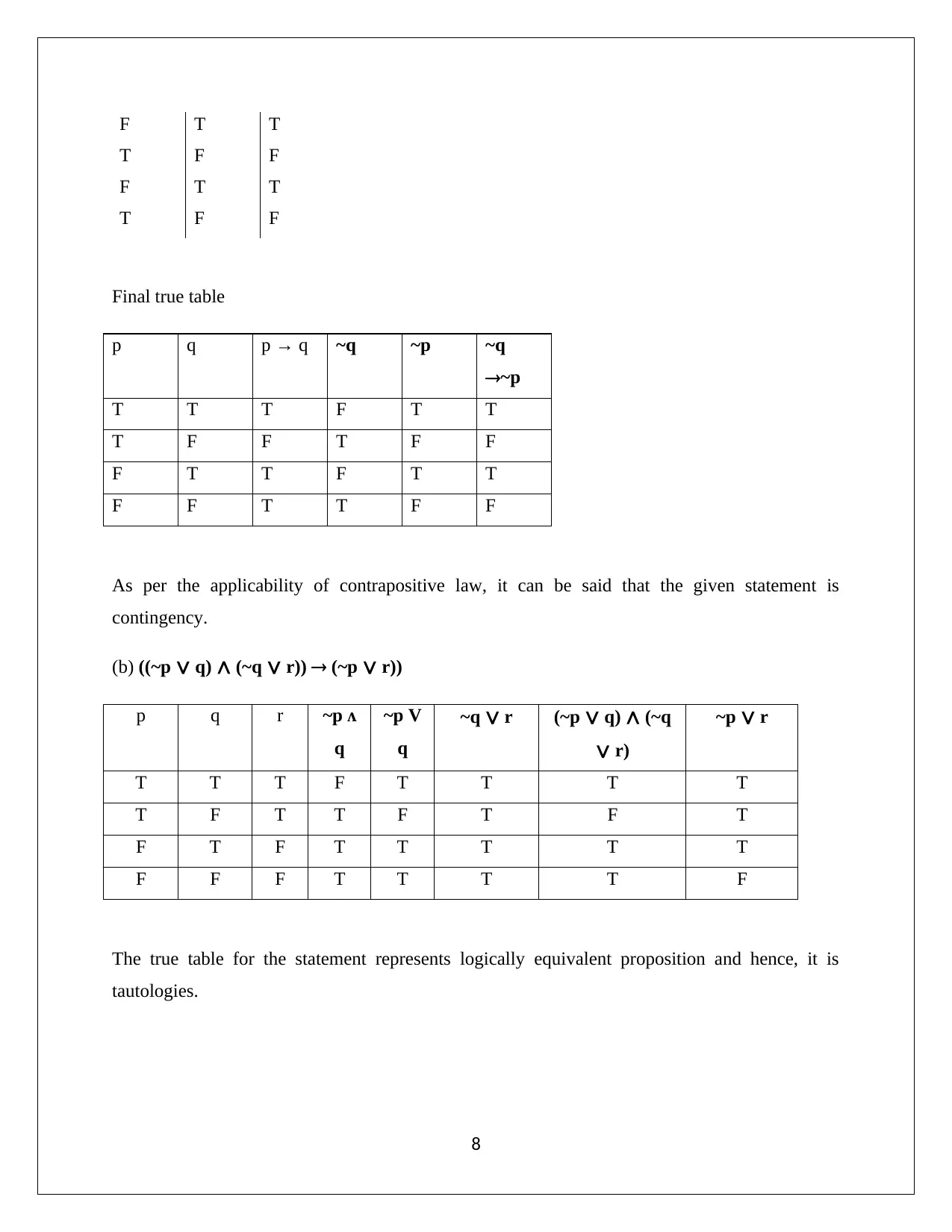
F T T
T F F
F T T
T F F
Final true table
p q p → q ~q ~p ~q
~p
T T T F T T
T F F T F F
F T T F T T
F F T T F F
As per the applicability of contrapositive law, it can be said that the given statement is
contingency.
(b) ((~p ∨ q) ∧ (~q ∨ r)) (~p ∨ r))
p q r ~p ᴧ
q
~p V
q
~q ∨ r (~p ∨ q) ∧ (~q
∨ r)
~p ∨ r
T T T F T T T T
T F T T F T F T
F T F T T T T T
F F F T T T T F
The true table for the statement represents logically equivalent proposition and hence, it is
tautologies.
8
T F F
F T T
T F F
Final true table
p q p → q ~q ~p ~q
~p
T T T F T T
T F F T F F
F T T F T T
F F T T F F
As per the applicability of contrapositive law, it can be said that the given statement is
contingency.
(b) ((~p ∨ q) ∧ (~q ∨ r)) (~p ∨ r))
p q r ~p ᴧ
q
~p V
q
~q ∨ r (~p ∨ q) ∧ (~q
∨ r)
~p ∨ r
T T T F T T T T
T F T T F T F T
F T F T T T T T
F F F T T T T F
The true table for the statement represents logically equivalent proposition and hence, it is
tautologies.
8
⊘ This is a preview!⊘
Do you want full access?
Subscribe today to unlock all pages.

Trusted by 1+ million students worldwide
1 out of 9
Related Documents
Your All-in-One AI-Powered Toolkit for Academic Success.
+13062052269
info@desklib.com
Available 24*7 on WhatsApp / Email
![[object Object]](/_next/static/media/star-bottom.7253800d.svg)
Unlock your academic potential
Copyright © 2020–2025 A2Z Services. All Rights Reserved. Developed and managed by ZUCOL.




